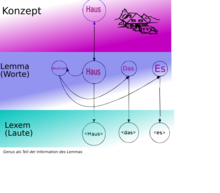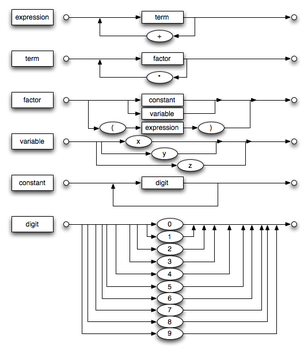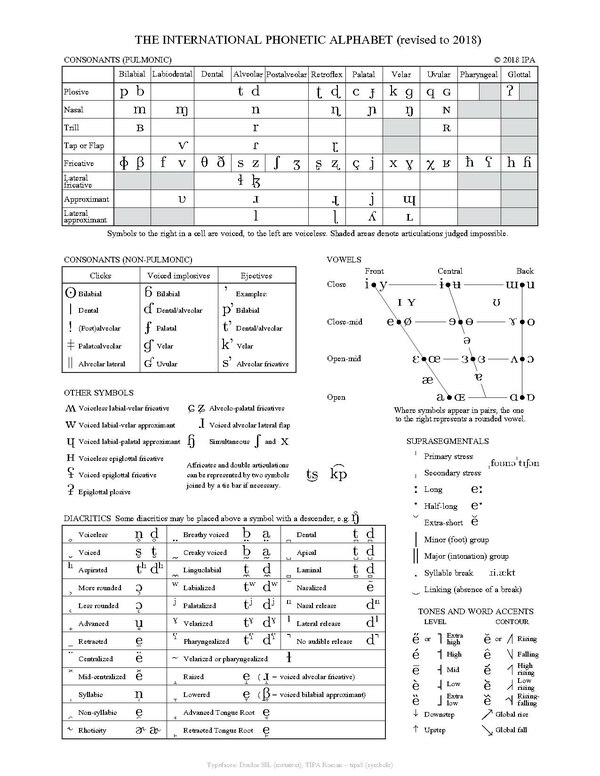4.5: The Structure of Language
- Page ID
- 5306
By definition, communication is behavior that affects the behavior of others by the transmission of information. Language is a series of codes made up of words and rules that allow humans to communicate. The structure of human language is complex and intricate and each language spoken in the world has different phonological systems, which is, by definition, the sounds that are used and how they are related to one another. The basic rules of language are covered here, including phonology, morphology, semantics, syntax, and how speech sounds are divided.
Phonology

Phonology is the use of sounds to encode messages within a spoken human language. Babies are born with the capacity to speak any language because they can make sounds and hear differences in sounds that adults would not be able to do. This is what parents hear as baby talk. The infant is trying out all of the different sounds they can produce. As the infant begins to learn the language from their parents, they begin to narrow the range of sounds they produce to one's common to the language they are learning, and by the age of 5, they no longer have the vocal range they had previously. For example, a common sound that is used in Indian language is /dh. To any native Indian there is a huge difference between /dh and /d, but for people like me who cannot speak Hindi, not only can we not hear the difference, but it is very difficult to even attempt to produce this sound. Another large variation between languages for phonology is where in your mouth you speak from. In English, we speak mostly from the front or middle of our mouths, but it is very common in African to speak from the glottal, which is the deepest part of one's throat. These sounds come out as deep growls, though they have great significance in African culture.
Morphology
The definition of morphology is the study of the structure of words formed together, or more simply put, the study of morphemes. Morphemes are the smallest utterances with meaning. Not all morphemes are words. Many languages use affixes, which carry specific grammatical meanings and are therefore morphemes, but are not words. For example, English-speakers do not think of the suffix “-ing” as a word, but it is a morpheme. The creation of morphemes rather than words also allowed anthropologists to more easily translate languages. For example, in the English language, the prefix -un means "the opposite, not, or lacking" which can distinguish the words "unheard" and "heard" apart from each other.

Morphology is very helpful in translating different languages, such as the language Bangla. For example, some words do not have a literal translation from Bangla to English because a word in Bangla may mean more than one word in English. Two professors from Bangladesh discovered an algorithm that could translate Bangla words, as they are generally very complex. They first search for the whole word. If this does not come up with results, they then search the first morpheme they find, in one example it was "Ma" of "Manushtir". "Ma" was a correct morpheme, however "ushtir" was not. The researchers then attempted "Man", however "ushtir" was not a correct morpheme. They next tried "Manush" and "tir", discovering that this was correct combination of morphemes. [9]
Semantics

Semantics is the study of meaning. Some anthropologists have seen linguistics as basic to a science of man because it provides a link between the biological and sociocultural levels. Modern linguistics is diffusing widely in anthropology itself among younger scholars, producing work of competence that ranges from historical and descriptive studies to problems of semantic and social variation. In the 1960's, Chomsky prompted a formal analysis of semantics and argued that grammars needed to represent all of a speaker's linguistic knowledge, including the meaning of words. Most semanticists focused attention on how words are linked to each other within a language through five different relations
- synonymy - same meaning (ex: old and aged)
- homophony - same sound, different meaning (ex: would and wood)
- antonymy - opposite meaning (ex: tall and short)
- denotation - what words refer to in the "real" world (ex: having the word pig refer to the actual animal, instead of pig meaning dirty, smelly, messy or sloppy)
- connotation - additional meanings that derive from the typical contexts in which they are used in everyday speech. (ex: calling a person a pig, not meaning the animal but meaning that they are dirty, smelly, messy or sloppy)
Formal semanticists only focused on the first four, but we have now discovered that our ability to use the same words in different ways (and different words in the same way) goes beyond the limits of formal semantics. Included in the study of semantics are metaphors which are a form of figurative or nonliteral language that links together expressions from unrelated semantic domains. A semantic domain is a set of linguistic expressions with interrelated meanings; for example, the words pig and chicken are in the same semantic domain. But when you use a metaphor to call a police officer a pig, you are combining two semantic domains to create meaning that the police officer is fat, greedy, dirty, etc. [8] [10]
Syntax

The study of the arrangement and order of words, for example if the Subject or the Object comes first in a sentence.
Syntax is the study of rules and principles for constructing sentences in natural languages. Syntax studies the patterns of forming sentences and phrases as well. It comes from ancient Greek (“syn”- means together and “taxis” means arrangement.) Outside of linguistics, syntax is also used to refer to the rules of mathematical systems, such as logic, artificial formal languages, and computer programming language. There are many theoretical approaches to the study of syntax. Noam Chomsky, a linguist, sees syntax as a branch of biology, since they view syntax as the study of linguistic knowledge as the human mind sees it. Other linguists take a Platonistic view, in that they regard syntax to be the study of an abstract formal system.
Major Approaches to Syntax
Generative Grammar: Noam Chomsky pioneered the generative approach to syntax. The hypothesis is that syntax is a structure of the human mind. The goal is to make a complete model of this inner language, and the model could be used to describe all human language and to predict if any utterance would sound correct to a native speaker of the language. It focuses mostly on the form of the sentence rather than the communicative function of it. The majority of generative theories assume that syntax is based on the constituent structure of sentences.
Categorial Grammar: An approach that attributes the syntactic structure to the properties of the syntactic categories, rather than to the rules of grammar.
Dependency Grammar: Structure is determined by the relations between a word and its dependents rather than being based on constituent structure.
Computational Analysis of Syntax of ancient Indus symbols
One recent case of computational analysis of the syntax of an unknown language comes form the work of Rajesh P. N. Rao (2009[11]) at the Dept. of Computer Science & Engineering, University of Washington. His team's computational analysis decoding patterns in the ancient Indus script has shown that it is in fact patterned like spoken language. Like spoken language, the Indus symbols follow a degree of ordering that is intermediate between highly patterned systems such a computer programming languages and highly variable systems such as the DNA code. Further analysis of the pattern of symbols with unknown meaning has linked it to the ancient Sumerian language of Mesopotamia and Old Tamil from India.
Speech Sounds
Human Speech sounds are traditionally divided between vowels and consonants, but scientific distinctions are much more precise. An important distinction between sounds in many languages is the vibration of the glottis, which is referred to as voicing. It distinguishes such sounds as /s/ (voiceless;no vibrating) and /z/ (voiced;vibrating). The chart below mentions pulmonic consonants, which are produced by releasing air from the lungs and somehow obstructing it on its way out the mouth. The non-pulmonic Consonants are clicks, implosives (similar to the 'glug-glug' sound sometimes made to imitate a liquid being poured or being drunk), and explosives. Co-articulation refers to sounds that are produced in two areas at once (like /W/).

Phoneme
A phoneme is the smallest phonetic unit in a language that is capable of conveying a distinction in meaning.[8] For example, in English we can tell that pail and tail are different words, so /p/ and /t/ are phonemes. Two words differing in only one sound, like pail and tail are called a minimal pair. The International Phonetic Association created the International Phonetic Alphabet (IPA), a collection of standardized representations of the sounds of spoken language. [9]
When a native speaker does not recognize different sounds as being distinct they are called allophones. For example, in the English language we consider the p in pin and the p in spin to have the same phoneme, which makes them allophones. In Chinese, however, these two similar phones are treated separately and both have a separate symbol in their alphabet. The minimum bits of meaning that native speakers recognize are known as phonemes. It is any small set of units, usually about 20 to 60 in number, and different for each language, considered to be the basic distinctive units of speech sound by which morphemes, words, and sentences are represented.[12]
Morpheme

Morphemes are "the smallest unit grammatical of language" that has semantic meaning. In spoken language, morphemes are composed of phonemes(the smallest unit of spoken language), but in written language morphemes are composed of graphemes(the smallest unit of written language). A morpheme can stand alone, meaning in forms a word by itself, or be a bound morpheme, where it has to attach to another bound morpheme or a stand alone morpheme in order to form a word. Prefixes and suffixes are the simplest form of bound morphemes. For example, the word "bookkeeper" has three morphemes: "book", "keep", and "-er". This example illustrates the key difference between a word and a morpheme; although a morpheme can be a standalone word, it can also need to be associated with other units in order to make sense. Meaning that one would not go around saying "-er" interdependently, it must be bound to one or more other morphemes.


